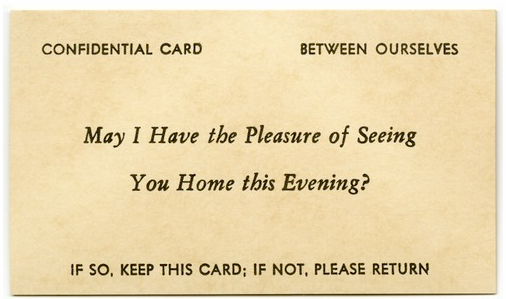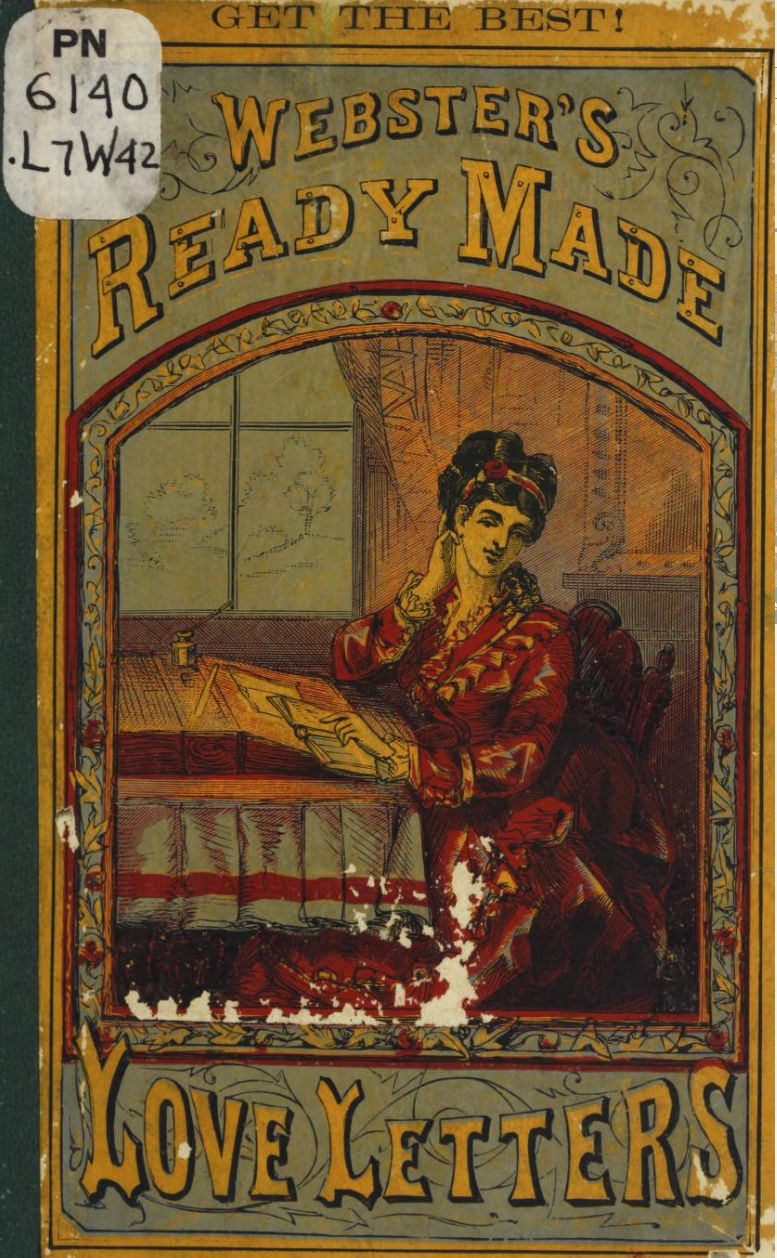created, $=dv.current().file.ctime & modified, =this.modified
tags:love
Using another’s words for your own
NOTE
(thinking of “Her” film, with protagonist’s job)
On class and love expression in writing, (first a bit arrogantly) Subject A,
“But I am an educated person, I have my own words. I wouldn’t take someone else’s”
Working class subjects interviewed viewed Hallmark cards as useful aids in expression of love. Subject B,
“I have feelings but I don’t have the words for it. (This doesn’t mean less complete at expressing love).
“Because romance in this form is culturally constructed as essentially linguistic form of expression, feelings of linguistic incompetence, spillover to the domain of romance.”
NOTE
That’s a bit of a tangled connection, but does work back to selection vs writing and the extent we all select. Like the guise of creativity (which can be part of romantic selection)
The prevalence of images of nature, and more specifically deserted beaches can be explained in terms of the ethos of this new class. The deserted beach is a liminal space that inverts the values of work and celebrates the wholesomeness of a fully recovered individualism, yet it presupposes the rental car agencies, shopping areas, cafes and restaurants that are now appendages of most beach resorts.
Beach clothing is close to nakedness, yet concerns about appearance are paramount because the body is supposed to be a sign of good care, health and fitness that is the ethos of the new bourgeoisie .
The beach is also an ideal type of ‘positional good’ the value of which derives from its scarcity and thereby depends on the number of people who want to consume it. That is, enjoyment one gets from the good depends on the monopoly over it.
Natural landscape is ‘objective scarcity’: the greater the number of people who consumes the landscape the less one particular individual can enjoy it. Thus capitalism is has appropriated and destroyed not only the natural landscape but the ability to enjoy the landscape uncontaminated by the individual hand of capital.
Advertising
Some convoluted copy of an early bran advert, tying lasting romance to bran
Romance never left their home. Through the years her husband adored her But such devotion was easy to explain. She had those possessions which women know are priceless. Sparkling eyes. A lovely skin. A radiant manner Charms that health alone can give. Isn’t it a pity that countless women who strive for such health and beauty do not realize why they are so unsuccess- ful? Body toxins are often the reason—insidious poisons which are the result of constipation. Many have constipation and do not know it. They are only aware of what are often the effects. Sallow skin. Dull eyes. Fatigue. But con• stipation can be safely relieved and prevented. Thousands of women—men too, have freed themselves from body toxins. They have learned that their systems need roughage regularly. And they have found this necessary roughage in Kellogg’s All Bran
There’s this segment which related to this “truck” thought I am replying to.
There were eight million car owners after World War I, and the number had tripled by 1930. By facilitating the search for privacy, it re- placed the “parlor” as the scene of courting for the upper middle class es- pecially, thus enabling beginning couples to “get much further away from front porch swings, parlor sofas, hovering mothers, and pesky siblings than ever before” —increasing the opportunities to act out the increasing sex- ual freedom of the post-Victorian era “As soon as manufacturers began to put a roof over motorists’ heads, with the innocent idea of shielding them more effectively from the weather, it was another story. The motor- car (like the hansom cab) became an intimate and exciting little box, and it is basic if little-advertised human law that men and women cannot be tucked side by side into cosy little boxes without getting ideas in their heads. ” Many of the songs of the period from 1900 to 1930 testify to this. For example, one written in 1905 celebrates being “Out in an automobile, in with the girl that you love. Riding at ease on the wings of the breeze, like birds in the blue sky above. Teach her to steer the machine, get both her hands on the wheel. You kiss and you squeeze just as much as you please. Out in an automobile.”
NOTE
Also reminded me of something I noticed with my post card collection (and became a focus of collection), a boating trip scene as romance (some connection to isolation of the lovers).
NOTE
Connecting to Duchamp and “choosing”/readymades - the text had brought this up. (transition from calling, to dating)
Was also connected the job of the protag in “Her,” those pre-crafted letters
I found the full text
Also, somewhat unrelated (blatantly simple and obvious) thought that came to me. How an artist seems to have greater ability to touch their art than anyone else.
You can imagine a scene where people are in a gallery, looking at it. It seems a transgression, or you’d be terrified to reach out and touch something. But I do feel like there would be freedom for an artist to handle what they’ve made that isn’t granted elsewhere.
Just reeling imagining the interaction here. A suitor proffering this calling card, it being favorably received, and he looks up his ready made love letter book and copies the following Just reeling imagining the interaction here. A suitor proffering this calling card, it being favorably received, and he looks up his ready made love letter book and copies the following

Florists turn feelings into flowers.
Has the sphere of consumption robbed romance of a meaning hitherto preserved by precapitalist culture? Has it undermined the capacity of people to engage in an authentic experience of romance? Does the transient, fragmentary nature of postmodern romantic experience render romance meaningless, or does postmodern culture offer others ways of making romantic meaning?
Reenchanting the World
Courtship is commonly referred to as a ritual. The metaphor may have roots in premodern courtship, which followed a highly codified sequence of actions analogous to formal rituals but because 20th century manners has swept away the rigidity of courtship etiquette, the metaphor of ritual would be obsolete, no longer capturing the symbolic meaning of romance. However, a cultural analysis of moderns romantic practices, reveal that the meaning of romance does in indeed draw from religious rituals, even more literally than is implied by the world “ritual.”
NOTE
The Anti-Dates are our only spiteful salvation, a space of nonsense for which we can discern what our love means by experimentation and refutation of blanket prescription.
Ritual and symbolic space: these can be broken down into, temporal, emotional, spatial, and artifactual. They carve a symbolic space within which romance is lived in the mode of ritual.
-
Temporal - sacred time has boundaries, that is points where things start and end. A person experiences a romantic moment as taking place a different time from “regular” profane time. “You have to set aside time to make things romantic”. This time is constructed to mark out “special” things explicitly opposed to the “ordinary” time of everyday life.
Night is more romantic than day, because it facilitates the both symbolic and physical isolation from their ordinary daytime identities.
-
Spatial - The setting of new spatial boundaries marks the experience of romance, as evidenced by people’s need to move away from their regular domestic space. Although isolation and privacy are intrinsic elements of romance, that how is frequently viewed as unromantic suggests that romance is equated with a couple’s ability to construct a new private space, even around a public space
NOTE
A home is romantic, it’s just an every day default. There’s less novelty, or at least it becomes a challenge to make it novel.
- Artifactual - Ritual objects become more precious or beautiful than ordinary ones. Gifts are the obvious example, but elegant clothes and expensive meals are also associated with romance. Religious rituals have special vestments and beverages. Items can acquire a sacredness by virtue of their association with intense romantic feelings, for example a scarf or a napkin used on a romantic occasion can be impregnated with sacredness, able to transport the lover back to the “sacred” moment of the first meeting.
- Emotional - the very ability to feel love might be jeopardized, if the romantic feeling isn’t viewed as different, or unique. It must be unambiguously distinguished from other feelings. When asked if there is a difference between friendship and love, everyone says with no hesitation that the two are different and have to be different, even if they claim at the same time friendship is a subcomponent of love.
Consumption
| Activities | Direction Consumption | Indirect | No Consumption |
|---|---|---|---|
| Gastronomic | Restaurant, Drink | Dinner at home | - |
| Cultural | Movies, Theater, Dancing, Opera, Museum | Reading a book, listening to music, painting together, photos | Talking, sharing secrets, talking about arts and politics |
| Touristic | Cruise, Skiing, Travel, Waterskiing, Canoe | Fishing, Gardening, Picnicking | Walking (river or woods; city street or park) |
| Direct = romantic moment is predicated on the purchase of a commodity. | |||
| Indirect = romantic moment depends on the consumption but it not the direct outcome of purchasing a good. | |||
| Without = any romantic activity that takes place without mediation of consumption. |
The only respondents who sustained romantic interactions without the mediation of a technology or commodity were the ones with the highest cultural competence.
Consumerist romantic moments serve as the standard against which nonconsumerist moments are constructed.
Of all romantic activities taking place within the framework of daily life, the sharing of food is the most frequently cited. Shared Plate
Association with romance with consumption is acquired earlier and is mentally more salient than the representation of nonconsumerist romantic moments.

